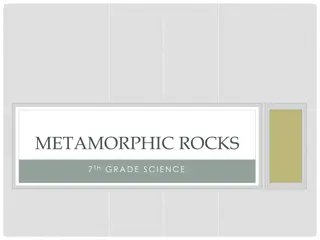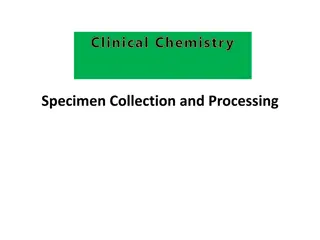Metamorphic Rocks Hand Specimen Laboratory Analysis
Explore a comprehensive laboratory examination of various metamorphic rock hand specimens, identifying types of metamorphism, mineral compositions, textures, and formation conditions. Utilize images for visual aid and delve into metamorphic processes and rock characteristics.
Download Presentation

Please find below an Image/Link to download the presentation.
The content on the website is provided AS IS for your information and personal use only. It may not be sold, licensed, or shared on other websites without obtaining consent from the author.If you encounter any issues during the download, it is possible that the publisher has removed the file from their server.
You are allowed to download the files provided on this website for personal or commercial use, subject to the condition that they are used lawfully. All files are the property of their respective owners.
The content on the website is provided AS IS for your information and personal use only. It may not be sold, licensed, or shared on other websites without obtaining consent from the author.
E N D
Presentation Transcript
Metamorphic Rocks in Hand Specimen In this laboratory you will name, describe, and interpret metamorphic rocks in hand specimen. We will use the Metamorphic Rock site on Sketchfab. The appropriate link is embedded in each sample designation. Use Microsoft Word to answer the questions and identify each answer using the appropriate question number. The Word file is to be sent to Clara. Question 1. (Sample 1 ) - Is the rock a result of contact metamorphism or regional metamorphism? Give your reasons for making this choice. Question 2. (Sample 2) Name the rock. Why did you assign this name? Remember you are looking at an outcrop which is 10s of meters long and a couple of meters high. Question 3. (Sample 3) List and describe the five minerals found in the rock. Question 4. (Sample 4) Kyanite is found in this rock. Describe its appearance in the rock (not the ideal appearance you find using a Google search). Question 5. (Sample 5) In this rock, which mineral is an aluminum silicate?
Question 6. Based on the aluminum silicate polymorph found in each rock, determine the range of P-T conditions for the metamorphism for each of the Samples 3, 4, and 5. To answer this question you will need to refer to the P-T diagram for the aluminum silicate polymorphs. Question 7. (Sample 6) The specimen is essentially monomineralic. What is the mineral (hint: it has a Moh s hardness less than 5). Name the rock. Question 8. (Sample 7, Sample 8, Sample 9) Arrange these specimens in order of increasing metamorphic grade. Explain how you constructed this order. Are these rocks the result of contact metamorphism or regional metamorphism and what is/are the criteria you used to make this decision? Question 9. Compare Sample 9 and Sample 10 Which rock formed at the higher metamorphic grade and how did you make this determination. In terms of water loss, if the protolith for samples 9 and 10 was the same, which sample would have the greater water content? Explain your answer. Question 10. (Sample 11) Identify and name the three minerals in the rock. What was the original sedimentary rock? Thinking about metamorphic fluids, during metamorphism was the system open or closed with respect to CO2? Explain how you reached your conclusion.
Question 11. (Sample 12) Identify the two minerals that comprise this rock. Did metamorphism take place at low temperature and pressure? Explain your answer. Question 12. (Sample 13) Estimate the temperature of formation of this rock in terms of T and P (low, moderate, or high). How did you make this determination? Question 13. (Sample 14) Describe the appearance of staurolite in THIS rock (not what Google tells you). Since you can see the specimen in three dimensions, is there any pattern to the orientation of the staurolite crystals? If so, what is the pattern? Question 14. (Sample 15) Describe the actinolite crystals. Do they have a preferred orientation and, if so, what is the orientation? Question 15. (Sample 16) This rock is identified as an augen gneiss. Look up a description for augen gneiss. For this rock, describe the texture that indicates it is an augen gneiss. Question 16. (Sample 17) This rock contains 4 minerals. Describe the appearance of each mineral. For this particular sample, what is a simple criterion that will allow you to differentiate feldspar and plagioclase?
Question 17. (Sample 18) Name the two major minerals in this rock. Mineral #1 has well-developed crystal faces. Describe the shape of the crystal faces using terminology from the first part of the course. This is a metamorphic rock. Why do we get such well-developed crystal faces? Question 18. (Sample 19) Look at the specimen with the base vertical and the narrow edge facing you. Describe the appearance of the white mineral. What is the textural name given to this feature? The rock underwent shearing during deformation. What is the shear sense and how do you know? Question 19. (Sample 20) Has this rock been deformed during metamorphism? Describe the features in the rock that enable you to answer this question. Question 20. (Sample 21) Describe the texture of this rock.























